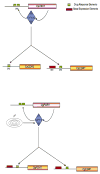Coordinate control of lipid composition and drug transport activities is required for normal multidrug resistance in fungi
- PMID: 19150512
- PMCID: PMC2671576
- DOI: 10.1016/j.bbapap.2008.12.012
Coordinate control of lipid composition and drug transport activities is required for normal multidrug resistance in fungi
Abstract
Pathogenic fungi present a special problem in the clinic as the range of drugs that can be used to treat these types of infections is limited. This situation is further complicated by the presence of robust inducible gene networks encoding different proteins that confer tolerance to many available antifungal drugs. The transcriptional control of these multidrug resistance systems in several key fungi will be discussed. Experiments in the non-pathogenic Saccharomyces cerevisiae have provided much of our current understanding of the molecular framework on which fungal multidrug resistance is built. More recent studies on the important pathogenic Candida species, Candida albicans and Candida glabrata, have provided new insights into the organization of the multidrug resistance systems in these organisms. We will compare the circuitry of multidrug resistance networks in these three organisms and suggest that, in addition to the well-accepted drug efflux activities, the regulation of membrane composition by multidrug resistance proteins provides an important contribution to the resistant phenotypes observed.
Figures



Similar articles
-
Curcumin potentiates the fungicidal effect of dodecanol by inhibiting drug efflux in wild-type budding yeast.Lett Appl Microbiol. 2019 Jan;68(1):17-23. doi: 10.1111/lam.13083. Epub 2018 Nov 19. Lett Appl Microbiol. 2019. PMID: 30276838
-
A Ste6p/P-glycoprotein homologue from the asexual yeast Candida albicans transports the a-factor mating pheromone in Saccharomyces cerevisiae.Mol Microbiol. 1998 Feb;27(3):587-98. doi: 10.1046/j.1365-2958.1998.00704.x. Mol Microbiol. 1998. PMID: 9489670
-
Regulation of multidrug resistance in pathogenic fungi.Fungal Genet Biol. 2010 Feb;47(2):94-106. doi: 10.1016/j.fgb.2009.08.002. Epub 2009 Aug 7. Fungal Genet Biol. 2010. PMID: 19665571 Review.
-
Yeast ATP-binding cassette transporters conferring multidrug resistance.Annu Rev Microbiol. 2012;66:39-63. doi: 10.1146/annurev-micro-092611-150111. Epub 2012 Jun 11. Annu Rev Microbiol. 2012. PMID: 22703054 Review.
-
Mechanisms of resistance to azole antifungal agents in Candida albicans isolates from AIDS patients involve specific multidrug transporters.Antimicrob Agents Chemother. 1995 Nov;39(11):2378-86. doi: 10.1128/AAC.39.11.2378. Antimicrob Agents Chemother. 1995. PMID: 8585712 Free PMC article.
Cited by
-
The Rbf1, Hfl1 and Dbp4 of Candida albicans regulate common as well as transcription factor-specific mitochondrial and other cell activities.BMC Genomics. 2014 Jan 22;15:56. doi: 10.1186/1471-2164-15-56. BMC Genomics. 2014. PMID: 24450762 Free PMC article.
-
Lipids of Candida albicans and their role in multidrug resistance.Curr Genet. 2013 Nov;59(4):243-50. doi: 10.1007/s00294-013-0402-1. Epub 2013 Aug 24. Curr Genet. 2013. PMID: 23974286 Review.
-
Disarming the Host: Detoxification of Plant Defense Compounds During Fungal Necrotrophy.Front Plant Sci. 2021 Apr 30;12:651716. doi: 10.3389/fpls.2021.651716. eCollection 2021. Front Plant Sci. 2021. PMID: 33995447 Free PMC article. Review.
-
Changes in the Biophysical Properties of the Cell Membrane Are Involved in the Response of Neurospora crassa to Staurosporine.Front Physiol. 2018 Oct 11;9:1375. doi: 10.3389/fphys.2018.01375. eCollection 2018. Front Physiol. 2018. PMID: 30364194 Free PMC article.
-
Negative regulation of Candida glabrata Pdr1 by the deubiquitinase subunit Bre5 occurs in a ubiquitin independent manner.Mol Microbiol. 2018 Oct;110(2):309-323. doi: 10.1111/mmi.14109. Epub 2018 Sep 30. Mol Microbiol. 2018. PMID: 30137659 Free PMC article.
References
-
- Akins RA. An update on antifungal targets and mechanisms of resistance in Candida albicans. Med Mycol. 2005;43:285–318. - PubMed
-
- Balzi E, Chen W, Ulaszewski S, Capieaux E, Goffeau A. The multidrug resistance gene PDR1 from Saccharomyces cerevisiae. J Biol Chem. 1987;262:16871–16879. - PubMed
-
- Bauer BE, Wolfger H, Kuchler K. Inventory and function of yeast ABC proteins: about sex, stress, pleiotropic drug and heavy metal resistance. Biochim Biophys Acta. 1999;1461:217–236. - PubMed
-
- Carvajal E, van den Hazel HB, Cybularz-Kolaczkowska A, Balzi E, Goffeau A. Molecular and phenotypic characterization of yeast PDR1 mutants that show hyperactive transcription of various ABC multidrug transporter genes. Mol Gen Genet. 1997;256:406–415. - PubMed
Publication types
MeSH terms
Substances
Grants and funding
LinkOut - more resources
Full Text Sources
Molecular Biology Databases

